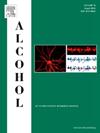Effects of daridorexant on rest/wake activity patterns and drinking in adult rats exposed to chronic ethanol vapor in adolescence
IF 2.9
4区 医学
Q3 PHARMACOLOGY & PHARMACY
引用次数: 0
Abstract
Disturbance in sleep and activity rhythms are significant health risks associated with alcohol use during adolescence. Many investigators support the theory of a reciprocal relationship between disrupted circadian rhythms, sleep patterns, and alcohol usage. However, in human studies it is difficult to disentangle other factors (i.e. lifestyle, psychiatric, genetic) when determining what is causal in the relationship between substance use and sleep/activity disruptions. To this end, we used an animal model of adolescent alcohol exposure whereby male and female Wistar rats are exposed to 5 weeks of intermittent alcohol vapor during adolescence (P22-P57). Five days after ethanol vapor rats were allowed to select to drink alcohol or water in a two-bottle choice procedure for a period of 5 h, 4 days a week for 6 weeks. Activity data was collected using a “Fitbit-like” device during vapor exposure, during acute withdrawal, and after 3 weeks of protracted withdrawal. Significant changes in rest/wake activity and circadian measures were seen during 24-h withdrawal and after 3 weeks of withdrawal. Four weeks following withdrawal, the effects of the dual orexin antagonist, Daridorexant, (DAX 30 mg, 100 mg, or vehicle control), on alcohol drinking and rest and activity rhythms were assessed over a 24 h period. Both daridorexant doses led to changes in circadian measures and rest/wake activity patterns. These results showed that daridorexant reduced activity, but it did not improve rest quality as measured by the mean inactive episode duration and inactive fragmentation ratio. Additionally, we did not find a significant difference in drinking behavior in animals treated with the orexin antagonist. Thus, it appears that data from this animal model do not support the use of this drug to improve adolescent alcohol-induced sleep disturbance and/or to decrease alcohol drinking.
daridorexant对青春期暴露于慢性乙醇蒸气的成年大鼠休息/清醒活动模式和饮酒的影响。
睡眠和活动节奏紊乱与青春期饮酒有关,是重大的健康风险。许多研究者支持昼夜节律紊乱、睡眠模式和饮酒之间存在相互关系的理论。然而,在人类研究中,在确定药物使用与睡眠/活动中断之间的因果关系时,很难理清其他因素(即生活方式、精神病学、遗传)。为此,我们使用了青春期酒精暴露的动物模型,雄性和雌性Wistar大鼠在青春期暴露于5周的间歇性酒精蒸气中(P22-P57)。乙醇雾化后5天,允许大鼠按照两瓶选择程序选择饮酒或喝水,每周4天,持续5小时,持续6周。在蒸汽暴露期间、急性停药期间和持续停药3周后,使用类似fitbit的设备收集活动数据。在24小时停药期间和停药3周后,观察到休息/清醒活动和昼夜节律测量的显著变化。停药4周后,在24小时内评估双食欲素拮抗剂Daridorexant (DAX 30mg、100mg或对照)对饮酒、休息和活动节律的影响。两种高剂量均导致昼夜节律测量和休息/清醒活动模式的变化。这些结果表明,daridorexant降低了活动,但通过平均非活动发作时间和非活动碎片率来衡量,它没有改善休息质量。此外,我们没有发现用食欲素拮抗剂治疗的动物在饮酒行为上有显著差异。因此,这个动物模型的数据似乎不支持使用这种药物来改善青少年酒精引起的睡眠障碍和/或减少饮酒。
本文章由计算机程序翻译,如有差异,请以英文原文为准。
求助全文
约1分钟内获得全文
求助全文
来源期刊

Alcohol
医学-毒理学
CiteScore
4.60
自引率
4.30%
发文量
74
审稿时长
15.6 weeks
期刊介绍:
Alcohol is an international, peer-reviewed journal that is devoted to publishing multi-disciplinary biomedical research on all aspects of the actions or effects of alcohol on the nervous system or on other organ systems. Emphasis is given to studies into the causes and consequences of alcohol abuse and alcoholism, and biomedical aspects of diagnosis, etiology, treatment or prevention of alcohol-related health effects.
Intended for both research scientists and practicing clinicians, the journal publishes original research on the neurobiological, neurobehavioral, and pathophysiological processes associated with alcohol drinking, alcohol abuse, alcohol-seeking behavior, tolerance, dependence, withdrawal, protracted abstinence, and relapse. In addition, the journal reports studies on the effects alcohol on brain mechanisms of neuroplasticity over the life span, biological factors associated with adolescent alcohol abuse, pharmacotherapeutic strategies in the treatment of alcoholism, biological and biochemical markers of alcohol abuse and alcoholism, pathological effects of uncontrolled drinking, biomedical and molecular factors in the effects on liver, immune system, and other organ systems, and biomedical aspects of fetal alcohol spectrum disorder including mechanisms of damage, diagnosis and early detection, treatment, and prevention. Articles are published from all levels of biomedical inquiry, including the following: molecular and cellular studies of alcohol''s actions in vitro and in vivo; animal model studies of genetic, pharmacological, behavioral, developmental or pathophysiological aspects of alcohol; human studies of genetic, behavioral, cognitive, neuroimaging, or pathological aspects of alcohol drinking; clinical studies of diagnosis (including dual diagnosis), treatment, prevention, and epidemiology. The journal will publish 9 issues per year; the accepted abbreviation for Alcohol for bibliographic citation is Alcohol.
 求助内容:
求助内容: 应助结果提醒方式:
应助结果提醒方式:


